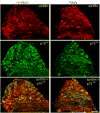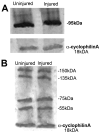Pro-NGF, sortilin, and p75NTR: potential mediators of injury-induced apoptosis in the mouse dorsal root ganglion
- PMID: 17964555
- PMCID: PMC2156563
- DOI: 10.1016/j.brainres.2007.09.051
Pro-NGF, sortilin, and p75NTR: potential mediators of injury-induced apoptosis in the mouse dorsal root ganglion
Abstract
The nerve growth factor precursor (pro-NGF) may function as a death-inducing ligand that mediates its apoptotic effects via p75NTR. Pro-NGF-induced apoptosis is postulated to be dependent upon membrane expression of the sortilin receptor, which interacts with p75NTR to promote a high-affinity binding site for pro-NGF. Here, we explore the expression of pro-NGF, sortilin and p75NTR in the mouse lumbar dorsal root ganglion (DRG) to understand the potential for this trimeric signaling complex to function in injury-induced neuronal death of DRG neurons. Our results reveal the expression of all 3 components within the DRG and that a subpopulation of neurons coexpresses sortilin and p75NTR. Following sciatic nerve transection, the expression of these proteins appears insensitive to injury; however, the majority of small p75NTR-sortilin coexpressing neurons are lost 25 days after sciatic nerve transection. These results propose pro-NGF-induced, p75NTR-sortilin-mediated neuronal death as a critical aspect of nerve injury-induced death in the DRG.
Figures





Similar articles
-
BDNF-TrkB and proBDNF-p75NTR/Sortilin Signaling Pathways are Involved in Mitochondria-Mediated Neuronal Apoptosis in Dorsal Root Ganglia after Sciatic Nerve Transection.CNS Neurol Disord Drug Targets. 2020;19(1):66-82. doi: 10.2174/1871527319666200117110056. CNS Neurol Disord Drug Targets. 2020. PMID: 31957620
-
ProBDNF induces neuronal apoptosis via activation of a receptor complex of p75NTR and sortilin.J Neurosci. 2005 Jun 1;25(22):5455-63. doi: 10.1523/JNEUROSCI.5123-04.2005. J Neurosci. 2005. PMID: 15930396 Free PMC article.
-
Differential effects of pro-BDNF on sensory neurons after sciatic nerve transection in neonatal rats.Eur J Neurosci. 2008 May;27(9):2380-90. doi: 10.1111/j.1460-9568.2008.06215.x. Epub 2008 Apr 22. Eur J Neurosci. 2008. PMID: 18430030
-
NGF and ProNGF: Regulation of neuronal and neoplastic responses through receptor signaling.Adv Biol Regul. 2015 May;58:16-27. doi: 10.1016/j.jbior.2014.11.003. Epub 2014 Nov 20. Adv Biol Regul. 2015. PMID: 25491371 Free PMC article. Review.
-
The proNGF-p75NTR-sortilin signalling complex as new target for the therapeutic treatment of Parkinson's disease.CNS Neurol Disord Drug Targets. 2008 Dec;7(6):512-23. doi: 10.2174/187152708787122923. CNS Neurol Disord Drug Targets. 2008. PMID: 19128208 Review.
Cited by
-
Presence of proNGF-sortilin signaling complex in nigral dopamine neurons and its variation in relation to aging, lactacystin and 6-OHDA insults.Int J Mol Sci. 2013 Jul 8;14(7):14085-104. doi: 10.3390/ijms140714085. Int J Mol Sci. 2013. PMID: 23880857 Free PMC article.
-
Peripheral nerve injury modulates neurotrophin signaling in the peripheral and central nervous system.Mol Neurobiol. 2014 Dec;50(3):945-70. doi: 10.1007/s12035-014-8706-9. Epub 2014 Apr 22. Mol Neurobiol. 2014. PMID: 24752592 Review.
-
Neurotrophin, p75, and Trk Signaling Module in the Developing Nervous System of the Marine Annelid Platynereis dumerilii.Biomed Res Int. 2016;2016:2456062. doi: 10.1155/2016/2456062. Epub 2016 Mar 16. Biomed Res Int. 2016. PMID: 27069919 Free PMC article.
-
Ectopic Expression of Sortilin 1 (NTR-3) in Patients with Ovarian Carcinoma.Avicenna J Med Biotechnol. 2009 Jul;1(2):125-31. Avicenna J Med Biotechnol. 2009. PMID: 23407681 Free PMC article.
-
ProNGF derived from rat sciatic nerves downregulates neurite elongation and axon specification in PC12 cells.Front Cell Neurosci. 2015 Sep 15;9:364. doi: 10.3389/fncel.2015.00364. eCollection 2015. Front Cell Neurosci. 2015. PMID: 26441535 Free PMC article.
References
-
- Chen Y, Dicou E, Djakiew D. Characterization of nerve growth factor precursor protein expression in rat round spermatids and the trophic effects of nerve growth factor in the maintenance of Sertoli cell viability. Molecular and Cellular Endocrinology. 1997;127:129–136. - PubMed
-
- Christianson JA, Ryals JM, McCarson KE, Wright DE. Beneficial actions of neurotrophin treatment on diabetes-induced hypoalgesia in mice. J Pain. 2003;4:493–504. - PubMed
-
- Christianson JA, Ryals JM, McCarson KE, Wright DE. Beneficial actions of neurotrophin treatment on diabetes-induced hypoalgesia in mice. J Pain. 2003;4:493–504. - PubMed
-
- Crockett DP, Harris SL, Egger MD. Neurotrophin receptor (p75) in the trigeminal thalamus of the rat: development, response to injury, transient vibrissa-related patterning, and retrograde transport. The Anatomical Record. 2000;259:446–460. - PubMed
MeSH terms
Substances
Grants and funding
LinkOut - more resources
Full Text Sources
Other Literature Sources

